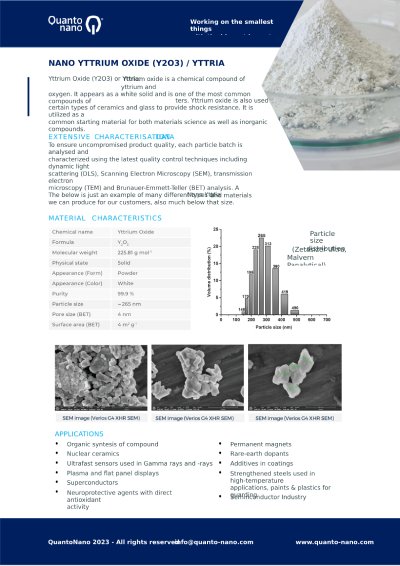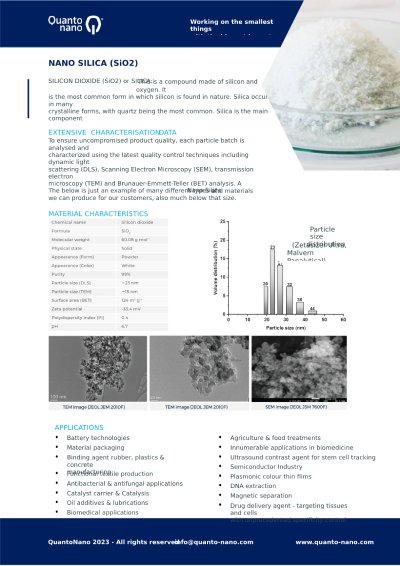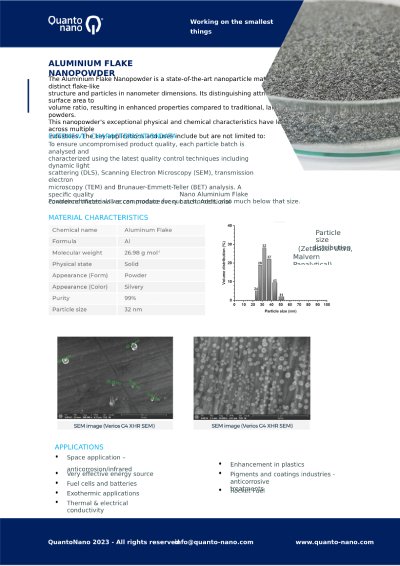Quanto Nano
Colloidal Systems
Quanto Nano
Product Categories
Quanto Nano
Innovation in Colloidal Systems and Nano Material Dispersions
Colloidal Systems: Definition and Characteristics
Quanto Nano
Key Features of Colloidal Systems
Quanto Nano
Properties & Behaviour
Quanto Nano
Types of Colloidal Systems
Sol
Solid particles in a liquid (e.g., ink).
Emulsion
Liquid droplets in another liquid (e.g., milk).
Foam
Gas bubbles in a liquid (e.g., whipped cream) or solid.
Aerosol
Liquid or solid particles in a gas (e.g., fog, smoke).
Quanto Nano
Formation and Stabilization
Dispersion Methods
Colloids can be formed by reducing the size of larger particles or aggregating smaller ones. Methods include grinding, emulsification, and condensation. Mechanical methods (e.g., milling, homogenization) or chemical methods (e.g., precipitation) can be used to disperse particles in the medium.
Nanoparticle production
Our proprietary top-down production Methods overcome typical limitations of other methods such as chemical reduction, sol-gel processes, or electrochemical techniques, enabling the production of nanoparticles with precise characteristics and constant quality without chemicals and lowest energy consumption.
Stabilization Techniques
Surface modification of nanoparticles with ligands, polymers, or surfactants can improve dispersion and stability within the medium. To prevent coagulation, clumping, settling or precipitation, stabilizing agents like surfactants may be added. Electrostatic or steric stabilization are also common methods.
Quanto Nano
The Science Behind Our Colloidal Systems
Key Features:
Uniform Dispersion
Ensures consistent properties and performance.
Ultrafine & Controlled Particle Size
Tailored nanostructures for specific applications. Ranging from 1 to 100 nanometers for increased surface area and interaction.
Surface Modification
Enhanced interaction with the medium for stability and functionality.
Benefits of Quanto Nano's Colloidal Systems
Quanto Nano
Diverse Applications of Our Nano Material Dispersions
Pharmaceuticals and Healthcare
Targeted drug delivery, improved diagnostic techniques, and advanced therapeutic solutions, systems utilizing nanoparticles for effective treatment with minimal side effects.
Cosmetics and Personal Care
Enhanced penetration, absorption, stability, and efficacy in skincare and cosmetic products through nano-sized particles.
Energy Storage and Conversion
Improved efficiency in batteries, fuel cells, and solar cells. In batteries and supercapacitors, nanoenhanced colloids contribute to improved energy capacity and charging rates.
Coatings and Paints
Advanced protective coatings with unique properties like self-cleaning, anti-corrosion, and UV protection.
Electronics and Optics
Miniaturization and enhancement of electronic components, improved optical devices. Used in the development of advanced display technologies and photonic devices due to their unique optical properties.
Catalysis
Nanoparticle colloids act as catalysts in chemical reactions, offering high surface area and active sites.
Environmental Applications
Pollution control, water purification, and sustainable materials. Nanoparticles in colloids for water and air purification, offering high efficiency in contaminant removal.
Quanto Nano
Examples of Nanomaterial Colloidal Systems
- Targeted Drug Delivery: Nanoparticles like liposomes or dendrimers can be used to deliver drugs precisely to the affected area, reducing side effects.
- Diagnostic Agents: Gold and silver nanoparticles in colloids can enhance imaging quality in diagnostic procedures like MRI and CT scans.
- Wound Healing: Silver nanoparticle colloids are used in wound dressings for their antimicrobial properties.
- Gold and Silver Nanoparticles: For targeted drug delivery and enhanced imaging.
- Liposomes and Dendrimers: Used in controlled drug release systems.
- Sunscreen Formulations: Titanium dioxide and zinc oxide nanoparticles provide effective UV protection while remaining transparent on the skin.
- Anti-Aging Products: Nanoparticles in creams and lotions can deliver active ingredients like vitamins or retinoids more effectively into the skin.
- Titanium Dioxide and Zinc Oxide Nanoparticles: In sunscreens for UV protection.
- Nano-Emulsions: For improved skin penetration in anti-aging products.
- Batteries and Supercapacitors: Nanoparticle colloids made from materials like graphene or silicon can increase the energy density and charging speed.
- Solar Cells: Quantum dots and other nanoparticles can be used in solar cells to improve their efficiency and light absorption capabilities.
- Graphene and Silicon Nanoparticles: In batteries and supercapacitors for increased energy density.
- Quantum Dots: Enhancing solar cell efficiency.
- Water Purification: Nanoparticles like titanium dioxide can degrade organic pollutants in water under UV light.
- Air Purification: Colloidal nanoparticles can be used in filters to capture and neutralize pollutants more effectively.
- Titanium Dioxide Nanoparticles: For photocatalytic water purification.
- Magnetic Nanoparticles: In air purification systems for pollutant capture.
- Conductive Inks: Silver nanoparticle colloids are used in conductive inks for printed electronics due to their high conductivity.
- Display Technologies: Quantum dots are used in display technologies for their color purity and energy efficiency.
- Silver Nanoparticles: In conductive inks for printed electronics.
- Quantum Dots: For color purity in display technologies.
- Self-Cleaning Surfaces: Titanium dioxide nanoparticles in coatings can break down organic dirt under sunlight.
- Corrosion Resistance: Nanoparticle colloids can be added to paints for enhanced corrosion resistance in metals.
- Silica Nanoparticles: For durable and self-cleaning coatings.
- Nanocomposite Coatings: Providing corrosion resistance and thermal insulation.
- Chemical Reactions: Metallic nanoparticles like palladium or platinum are used as catalysts to increase the efficiency of chemical reactions.
- Metallic Nanoparticles (Pd, Pt, Au): For various chemical reactions and catalytic converters.
- Bimetallic Nanoparticles: Offering synergistic effects in catalytic processes.
- Food Packaging: Nanoparticle colloids can be used in packaging materials to improve barrier properties or provide antimicrobial functions.
- Agricultural Formulations: Nanoparticles can enhance the effectiveness of pesticides or fertilizers.
- Nano-Encapsulated Nutrients: For enhanced food packaging and preservation.
- Nanopesticides: For more effective and controlled release in agriculture.
- Antimicrobial and UV Protective Clothing: Silver or zinc oxide nanoparticles in textile coatings provide antimicrobial and UV protective properties.
- Silver Nanoparticles: For antimicrobial and UV protective properties in fabrics.
Quanto Nano's Commitment to Research and Innovation
Our Focus:
Advanced Research Facilities
State-of-the-art laboratories and testing facilities.
Collaborations and Partnerships
Working with academic and industrial partners for mutual advancement.
Sustainable Practices
Developing processes and products that are environmentally friendly and sustainable.










